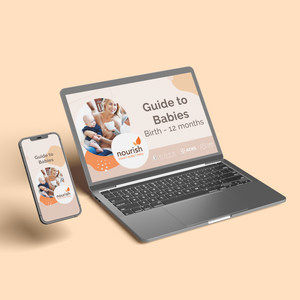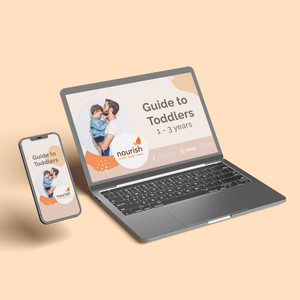Understanding Newborn Feeding Patterns
Many new mummies and daddies I speak to are genuinely surprised at how much time their babies spend breastfeeding in the early weeks.
During pregnancy, you read that babies feed every 3-4 hours, so that leaves at least a few hours to sleep in between feed cycles, right? Not always. On average, you can expect to be breastfeeding your newborn at least 8-12 times in 24 hours.
Feeds can take up to an hour when you count baby nodding off between sucks, nappy changes, burping and settling back to sleep, sometimes only leaving an hour before it all has to happen again, which is very trying at 3am!
Baby's Tummy Size and Feeding Capacity
At birth, a baby’s tummy is only the size of a small marble, or 5ml in size, which is perfect for digesting the low-volume, antibody-rich colostrum.
At day 3, the tummy is like a large marble, or 45ml, and from 10 days, it’s about the size of a golf ball, or 60ml in capacity.
Although the breasts don’t come with a gauge on them to let us know how much baby is drinking, once your milk is in, if your breasts feel softer and more drained after feeds, this is a great sign that your baby has drunk his fill.

Breastmilk Digestion and Nappy Checks
Breastmilk is very easily digested and only takes 45 minutes to pass through a baby’s system. What goes in has to come out, so another way you can tell your baby has had enough is by checking his nappies.
After a baby is 10 days old, I like to see 4-5 heavily wet disposables in 24 hours (6-8 if you’re using cloth). To get a feel for what is heavily wet, pour 60ml of water into a nappy and get to know how that feels.
In the first 4-6 weeks, there are usually little squirts of poo in most nappies, and sometimes a few bigger ones, which are usually pretty liquidy and yellow and can look a little like seeded mustard.
Signs of a Well-Fed Baby
As well as softer breasts and wet and pooey nappies, look for signs of your baby settling down after feeds. There’s usually at least one feed in 24 hours where baby is very unsettled, but if she’s settled after most other feeds, and gets that lovely milk-drunk look, he’s doing well.
I am often asked whether to offer one breast or two, and this changes from baby to baby. The best thing to do is to watch your baby’s active sucking. If you can see lots of jaw action, great! You’ll find after a while that your baby’s sucking slows down, and he may even release the breast himself.
Otherwise if you can’t get much more out of him, it may be time to change the nappy to wake him up a bit and change sides. Offer the second breast. Some babies are just so blissed out on breastmilk that they just aren’t interested.
Others may jump on and actively suck for a while but peter out much earlier than they did on the first side. This is fine. At the next feed, you can start on the breast he didn’t take or took less of.
The Reality of Snack Feeding
Lastly, I’d like to address the notion of snack feeding. Sometimes I hear mums are told not to encourage snack feeding, and make sure that baby has a nice, long feed every time he is at the breast.
My answer to that is to look at adult eating patterns. We don’t always feel like a three-course meal at every meal. We do sometimes just need an apple, or a couple of crackers, or are thirsty for a sip of water, or are ready for a cup of tea and a biccie.
To eat healthily, in fact, we are encouraged to have small meals throughout the day, rather than large, heavy ones. Babies are exactly the same. Sometimes they appear ravenous and suck away for ages.
Other times they only have a few half-hearted sucks and nod off but wake an hour later for another top-up. This is normal and natural, and to be expected. Follow your baby’s feeding cues and he will tell you what he needs — they’re clever things aren’t they?
About the Author: Jane Barry - Your Health Content Expert
Jane Barry is a registered nurse, midwife, and child health nurse with a passion for combining clinical expertise and writing. She has nearly 30 years of specialist experience in child health nursing and holds a Bachelor's Degree in Applied Science (Nursing). Jane specialises in women’s health, parenting, pregnancy, babies and maternity care, child health, nutrition, feeding, teething, and dental health issues.
An active member of AHPRA, The Australasian Medical Writer’s Association, Health Writer Hub, and the Australian College of Children and Young People’s Nurses, Jane Barry delivers health content with professionalism and clarity.
Our Products
-

01. Guide to a Healthy Pregnancy
$55 -

02. Positive Birthing Course
$55 -

03. Infant Feeding Guide
$55 -

04. Baby Sleep Guide - First 12 Months
$55 -

05. Toddler Parenting Course 1 - 3 Years
$55
-
 When to Start Antenatal Classes?
When to Start Antenatal Classes?
Becoming a parent is an incredible milestone, but it comes with a host of changes that can be daunting, especially for first time parents. Antenatal classes are all about offering expectant parents the education they need to make informed decisions, look after their bodies and care for their newborn babies. While you probably already have a long list of things you need to accomplish during your pregnancy, it’s a good idea to make time to attend antenatal classes.
-
 Development Milestones 4-8 Months
Development Milestones 4-8 Months
As they reach the middle of their first year, you'll start to see bigger leaps in their growth and ability!
In this article, we’re going to discuss your baby’s developmental milestones between 4-8 months, and what you can expect along the way.





 When to Start Antenatal Classes?
When to Start Antenatal Classes?
 Development Milestones 4-8 Months
Development Milestones 4-8 Months








